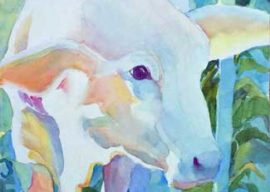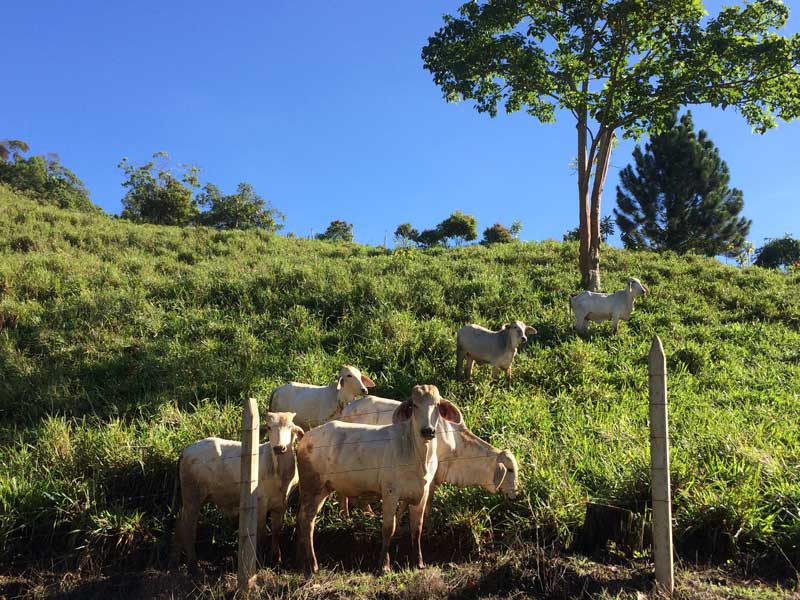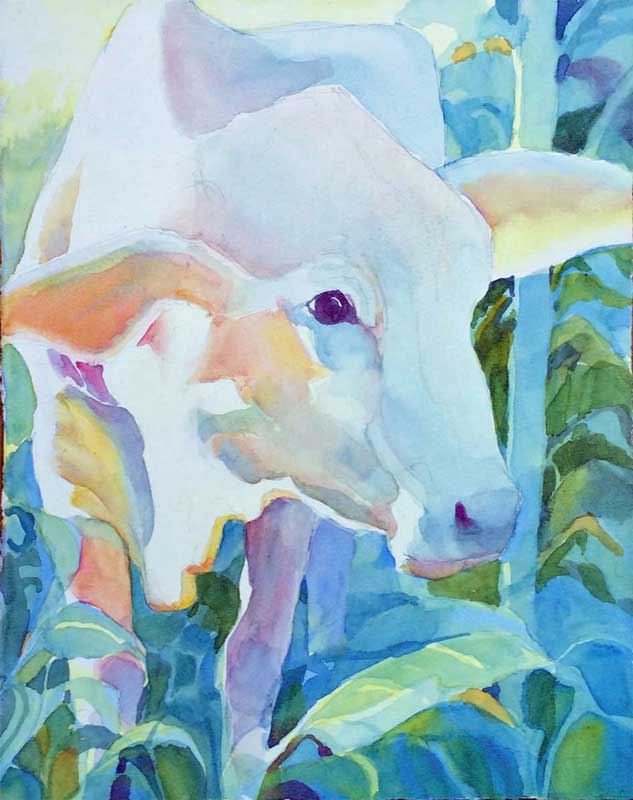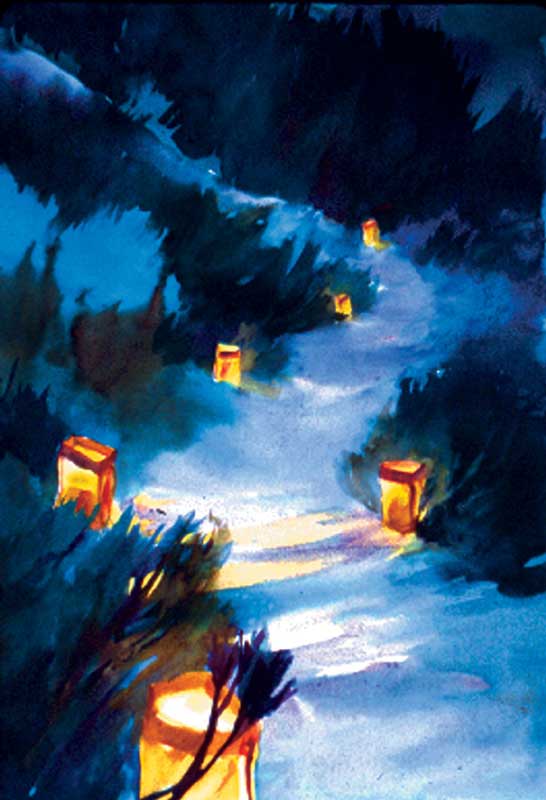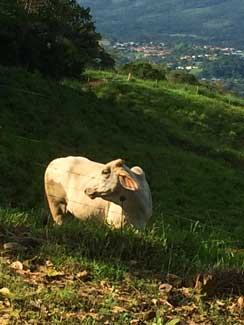 I am always startled by the white object in the landscape. Suddenly – there it is! And just as suddenly I am thinking about light – and composition, a different perspective, color ideas, etc. It all happens so fast that sometimes the moment passes before the requisite translators have successfully created an idea for a painting. But sometimes the moment is caught on camera or in a sketch for later.
I am always startled by the white object in the landscape. Suddenly – there it is! And just as suddenly I am thinking about light – and composition, a different perspective, color ideas, etc. It all happens so fast that sometimes the moment passes before the requisite translators have successfully created an idea for a painting. But sometimes the moment is caught on camera or in a sketch for later.
It happened to me not long ago on a morning walk with my dogs. The mostly white Brahmin cattle were near the road in the deep grasses and one turned its head to exhibit a perfectly profiled head with under-jaw, neck and shoulders in the blue gray of shade and shadow. Instantly I saw the painting, though I haven’t yet painted it. There with the darkened pasture beyond and valley villages below. I’ve marked it in my mind to paint and already know where some of the lost edges and reflected light will be.
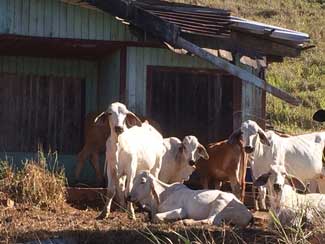 On another morning I saw several white Brahmins standing and lying in front of the old falling down wooden house in the pasture just below my home. Another painting nearly painted itself in my mind – with the ‘trail of light’ and blue cast shadows I so often talk about in my Intensives and workshops.
On another morning I saw several white Brahmins standing and lying in front of the old falling down wooden house in the pasture just below my home. Another painting nearly painted itself in my mind – with the ‘trail of light’ and blue cast shadows I so often talk about in my Intensives and workshops.
And then another morning I saw the small herd of Brahmins kind of strewn out on the hillside above the road and imagined the lovely trail of light that could move somehow from the lower left up and along a languid line across the head and back of one bovine to the shoulder of the next and then leap to a spark of light on one beyond. And on….It would take some doing but what a lovely endeavor. I could even let it wind up in some lighted clumps of leaves in the upper right. Can hardly wait!
I am reminded of John Singer Sargent and his wonderful paintings of white Brahmins.
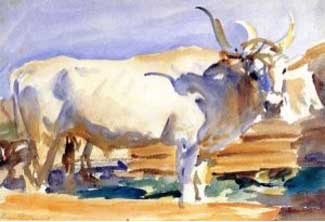
White Bull – John Singer Sargent
For painting the white Brahmins I would only use three transparent watercolor paints: Aureolin Yellow, Rose Madder Genuine and Cobalt Blue – perfect present day transparent adaptations to the remembered classics of white cows painted by John Singer Sargent. (I believe Sargent actually used Yellow Ochre, Burnt Sienna and Ultramarine Blue in his exquisite
When I am able to paint the white Brahmins, I will take care paint around the light. I can soften an edge here and there to allow for a more gentle transition into the shaded areas but it would simply be the white of my watercolor paper that would show itself as dazzling light. After all – in the purest and most direct light, all color, details and nuances are simply washed away.
I remember back a year to another painting I did of a white Brahmin, and I show the steps I took to glaze and define this beautiful and gentle subject.
Night is another subject entirely.
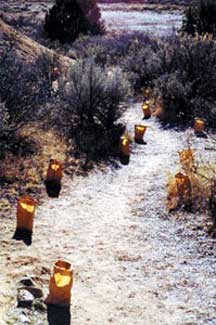 ‘Farolito Pathway’, painted in 2004 was more of a lesson for me than I knew. I thought it was about light – daylight vs. night. Turns out there was a larger lesson.
‘Farolito Pathway’, painted in 2004 was more of a lesson for me than I knew. I thought it was about light – daylight vs. night. Turns out there was a larger lesson.
My students arrived and I told them we were going to learn how to paint the night and I gave them a photo we would use as a reference. It was a photo I had taken at Christ in the Desert Monastery one Christmas day. A path wound through the New Mexico sages and chamisas, lined with burned out farolitos (little lights) that are simple paper sacks, rolled over at the top – with a measure of sand holding a votive candle. It is a New Mexico tradition to line the paths and roadways on Christmas eve with lighted farolitos.
My science loving mind loved the challenge as I explained about vision and the role of ‘rods’ and ‘cones’, our visual sensory cells. At night, under low light conditions our visual receptors are mostly limited to our ‘rods’ – useful for seeing darks and lights, but little color – blues, a bit of blue green and grays. A lighted object (farolito) could be seen with all our color receptors (cones). I remember them kind of groaning and then saying, ‘After you, Jan’…
This was what I painted that evening as a demo – and perhaps one of my favorite paintings of all time. In the darkenss, all the shapes are seen as neutrals and bluish. There may be a suggestion of moonlight upon the path but the farolitos are the only true points of light that allow our eyes to see the warmer colors – the oranges, yellows and reds.
Why is it that it is only now that I understand it?
Right now on earth we see so much – and it all looks kind of the same – the path ahead with the farolitos kind of blending in at the edge along and among the indistinct and scary shapes that line the way. Daylight exposes it all. But a simple shift to night, a different view changes everything. The scary shapes retreat a bit in the dark. Perhaps the path ahead, illuminated by those points of light is what we must now focus on. And it is up to us each to find and listen to those points of gentle illumination.

